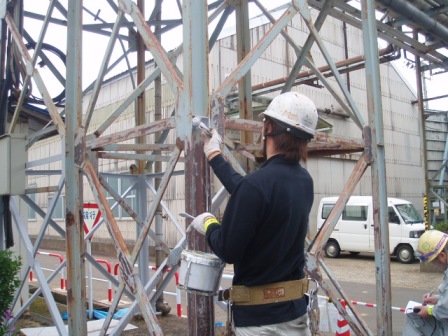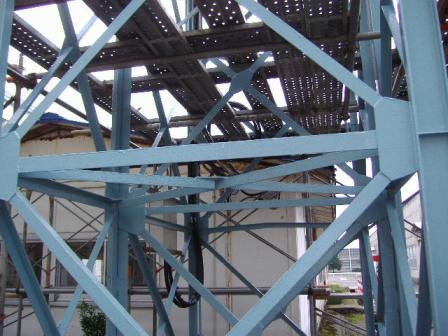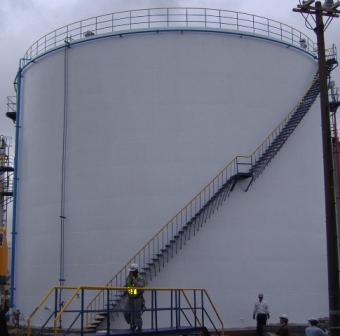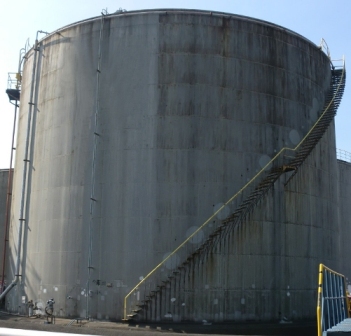Inquiries Concerning News
Corporate Communications Div.,
The Mitsubishi Chemical Group
TEL: +81-3-6748-7140
Full Introduction of the MY Protect SG System, an Anti-rust and Anti-corrosion Coating System
Jun. 27, 2013
Mitsubishi Plastics Infratec Co., Ltd. (Head office: Chuo-ku, Tokyo; President Masato Sasaki) has developed the MY Protect SG System, a new coating system employing three layers (modified epoxy resin, acrylic rubber, and urethane*1) that is particularly effective for preventing rust and corrosion, and will fully launch sales in July. Sales will target repair work on metal structures, facilities, and equipment. This system not only provides improved anti-rust properties as a result of the use of acrylic rubber with outstanding water barrier properties due to water retention as an intermediate layer but also cuts work time and costs by reducing the necessary number of coats to three from four (modified epoxy resin, modified epoxy resin, urethane resin, and urethane resin), which has recently been the main system used for multilayer-coating to prevent corrosion. Compared to the general three-layer system (modified epoxy resin/urethane resin/urethane resin), this new system also reduces life-cycle costs since it is more durable and can be used for a long time.
The use of anti-rust and anti-corrosion coating is indispensable for controlling rust and corrosion on metal structures in harsh exterior environments and facilities and equipment used in environments with high humidity or where acidic chemicals or similar materials are used. However, when selecting a system, potential buyers stress a coating system that is easy to apply, comparatively inexpensive, and environmentally friendly in order to reduce facilities maintenance costs on account of the weak economy and to protect the environment.
Mitsubishi Plastics Infratec has used MY Roofer, an acrylic rubber–based water-resistant coating system, for factory roofs and similar structures since 1998. During that time, we detected the outstanding anti-rust properties of acrylic rubber and began work to apply these properties and develop a coating system that is particularly good at preventing rust in 2007. Since 2009, we have conducted joint research with the Building Material Engineering Lab. of Tokyo University (Associate Professor Takafumi Noguchi), and the superior water barrier properties of an acrylic rubber layer due to moisture retention and its ability to prevent the penetration of moisture to objects that have been coated with the layer have been reported at academic conferences.*2 In addition, good results have been obtained with the system when used for steel structures and plants of petrochemical and steel manufacturers.
Using this research and experiments, we developed the anti-rust and anti-corrosion MY Protect SG System that uses three coats (undercoat, intermediate coat, and overcoat) as the standard type. The undercoat is Anti-rust Coat Fe, a mixture of various materials including a rust converter and anti-rust pigments that is based on a modified epoxy resin that does not contain chrome or lead. The intermediate coat is acrylic rubber BB Coat that prevents moisture from penetrating to the undercoat. The acrylic rubber coat also reduces the release of volatile organic compounds (VOC) since it is water based. Even if there is a crack in this coat due to birds or some other reason, the crack width narrows on account of the elastic properties of the acrylic rubber. The standard overcoat is made from a urethane resin with outstanding weather-proof properties in order to protect the acrylic rubber layer.
Using a comparison of this new system’s performance with that of traditional systems and the reduced life-cycle costs as selling points for the new system, we will propose this new system be used for a wide-range of items, including steel frameworks, roofs, walls, and tanks at plants near the coast that are prone to corrosion due to salt damage and facilities and equipment in environments that are conductive to rusting, such as ones with high humidity or ones where acidic chemicals or similar materials are used, and strive to expand sales.
*1 In addition to the urethane resin, various other resins, including acrylic silicon resins and fluororesin, can be used depending on the environment that the system will to be used in.
*2 We have conducted joint research with the Building Material Engineering Lab. of Tokyo University (Associate Professor Takafumi Noguchi) on the topic of clarifying and examining the anti-rust mechanism of acrylic rubber layers since May 2009.
(1) An Examination of the Role of a Water-resistant Coating’s Acrylic Rubber Layer in Preventing Rust, AIJ Journal of Technology and Design issued by Architectural Institute of Japan (June 2011).
(2) Research on the Role of an Anti-rust Coating’s Acrylic Rubber Layer in Preventing Rust (paper presented at the Architectural Institute of Japan Annual Convention (Kanto), August 2011)
(3) An Electrochemical Examination of the Anti-rust Mechanism of Water-based Acrylic Rubber (paper presented at the Architectural Institute of Japan Annual Convention (Tokai), September 2012)
Standard specification
Undercoat, Material:Modified epoxy resin, Application amount:0.15-0.20(kg/m2), Number of coats:1, Dried standard coating thickness:50μm
Intermediatecoat, Material:Acylic rubber, Application amount:0.25-0.30(kg/m2), Number of coats:1, Dried standard coating thickness:65μm
Overcoat, Material:Urethane resin, Application amout:0.15-0.20(kg/m2), Number of coats:1, Dried standard coating thickness:40μm
Dried standard coating thickness is the minimum coating thickness for the coating to demonstrate anti-rust properties.
Application cases:
Pipe rack


Before application After application
Raw material tank


Before application After application
The product is designed to offer domestic customers in principle: there will be a need for various procedures for confirmation in the case of export
For further information please contact:
Public Relations and Investor Relations office,
Mitsubishi Chemical Holdings Corporation.
TEL: +81-3-6748-7140
